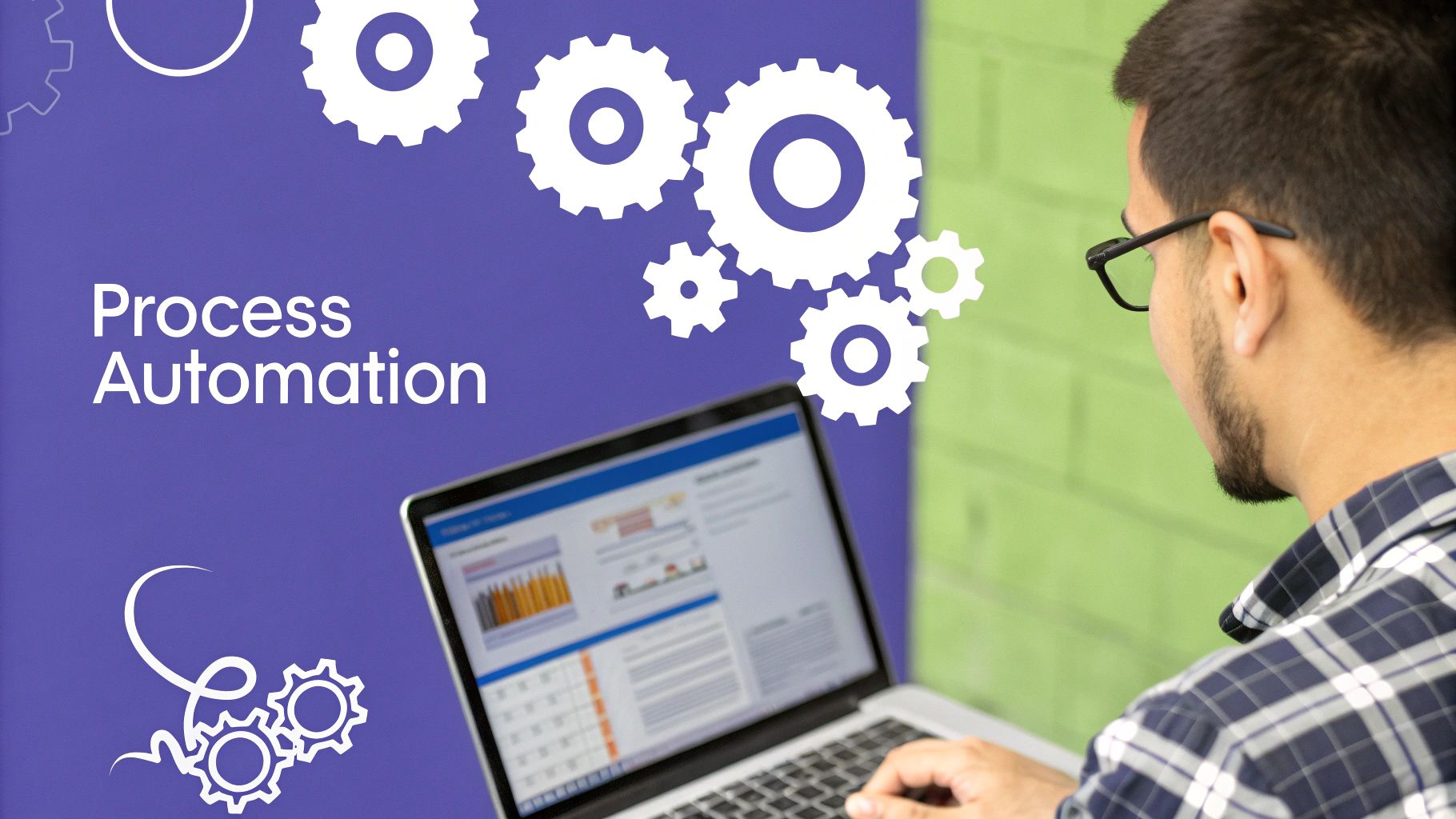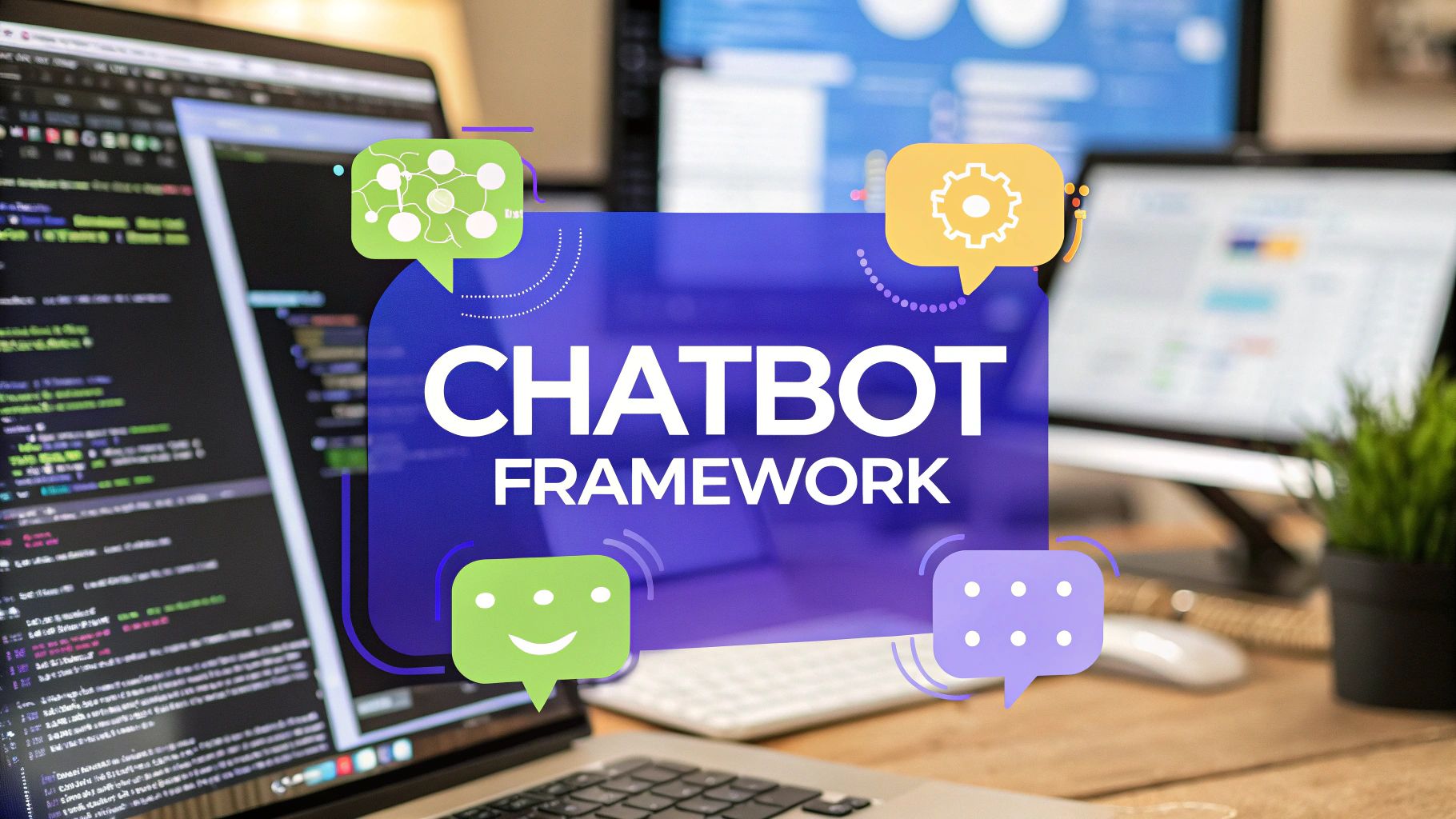8 Actionable Ways to Improve Team Productivity in 2025
Discover 8 proven strategies to improve team productivity. From Agile to AI automation, learn actionable tips and tools to elevate your team's performance.

In today's competitive business environment, the ability to improve team productivity is not just an advantage; it is a fundamental requirement for success. High-performing teams are not born from chance. They are meticulously built through a deliberate combination of intelligent strategies, efficient systems, and powerful tools designed to optimize every workflow. Yet, many organizations find themselves stuck, implementing generic advice that fails to address the deep-rooted causes of inefficiency, leading to stalled projects and frustrated team members.
This guide is designed to cut through the noise. We will explore eight powerful, actionable strategies that move beyond surface-level tips, offering fresh perspectives and concrete implementation steps. From mastering agile project management and setting clear Objectives and Key Results (OKRs) to leveraging the transformative power of AI with tools like Chatiant, you will gain a comprehensive blueprint for building a more focused, aligned, and efficient team. Prepare to move beyond theory and start implementing changes that will unlock unprecedented levels of performance and drive tangible results.
1. Master Flexibility with Agile Project Management
Rigid, long-term project plans often crumble under the pressure of real-world changes, leading to missed deadlines and frustrated teams. Adopting an Agile project management framework is a powerful strategy to improve team productivity by building adaptability directly into your workflow. Instead of a single, massive launch, Agile breaks projects into small, manageable cycles called "sprints."
This iterative approach allows teams to deliver functional pieces of a project in short bursts, typically lasting one to four weeks. Each sprint concludes with a tangible outcome, which can be reviewed by stakeholders. This constant feedback loop ensures the project stays aligned with evolving requirements and market needs, preventing wasted effort on features that are no longer relevant.
How to Implement an Agile Approach
Getting started with Agile doesn't require an overnight overhaul. Begin by introducing core Agile ceremonies:
- Daily Stand-ups: Host brief, 15-minute daily meetings where each team member shares what they did yesterday, what they will do today, and any obstacles they face. This simple practice dramatically improves communication and allows for rapid problem-solving.
- Sprint Planning: Before each sprint, the team gathers to define the work that can be accomplished. Tasks are pulled from a prioritized "product backlog" into the "sprint backlog," creating a clear, achievable goal for the cycle.
- Retrospectives: After each sprint, hold a meeting to discuss what went well, what didn't, and what can be improved. This commitment to continuous improvement is the engine that drives long-term productivity gains.
By embracing this flexible, feedback-driven mindset, your team can pivot quickly, reduce wasted time, and consistently deliver value.
2. Goal Setting and OKRs (Objectives and Key Results)
Teams often struggle with a lack of direction, where individual efforts are disconnected from larger company goals. The Objectives and Key Results (OKRs) framework is a powerful system to improve team productivity by creating a direct line of sight between daily tasks and strategic priorities. Pioneered at Intel by Andy Grove and popularized by companies like Google, OKRs pair ambitious, qualitative objectives with specific, measurable key results.

This structure provides clarity and purpose, ensuring every team member understands how their work contributes to the bigger picture. Instead of vague aspirations, teams have concrete targets to aim for, typically on a quarterly basis. This transparency fosters alignment across departments, reduces redundant work, and focuses collective energy on what truly matters for moving the organization forward.
How to Implement the OKR Framework
You can introduce OKRs gradually to create focus and drive performance. Start with a single team or department to pilot the process:
- Define Ambitious Objectives: An Objective is a memorable, qualitative description of what you want to achieve. It should be aspirational and inspiring. For example, "Launch the Most Successful Product in Our Category."
- Set Measurable Key Results: For each Objective, define 3-5 Key Results. These are quantitative outcomes that measure progress toward the objective. A Key Result for the example above could be, "Achieve 50,000 new user sign-ups in the first quarter."
- Conduct Regular Check-ins: OKRs are not a "set it and forget it" tool. Dedicate time in weekly meetings to review progress, discuss roadblocks, and adjust tactics as needed. This keeps the goals top-of-mind and ensures accountability.
By adopting this goal-setting discipline, your team gains a shared language for success, making it easier to prioritize tasks and make decisions that directly support key business outcomes.
3. Establish Effective Communication Systems
Disjointed conversations, missed updates, and information silos are silent killers of momentum. Establishing clear and effective communication systems is essential to improve team productivity by ensuring that information flows efficiently, accurately, and to the right people at the right time. This isn't just about having tools like Slack or email; it's about creating a deliberate protocol for how your team exchanges information.
A well-defined communication framework, like the one championed by GitLab in its all-remote model, reduces ambiguity and minimizes the time spent searching for context. It clarifies which channel to use for different types of conversations, preventing urgent updates from getting lost in casual channels and protecting focused work time from unnecessary interruptions.

How to Build a Communication Framework
Creating a system that works for your team involves defining and documenting clear guidelines. Start with these foundational practices:
- Define Communication Channels: Assign a specific purpose to each tool. For example, use email for formal, external communication, a project management tool for task-specific updates, and a dedicated chat channel for urgent, time-sensitive issues.
- Document Key Decisions: Create a centralized, searchable knowledge base or wiki where all important decisions, project plans, and process documents are stored. This single source of truth prevents knowledge loss and empowers team members to find answers independently.
- Schedule Regular Audits: Periodically review your communication practices with the team. Ask what's working, what's causing friction, and if new tools or protocols are needed. This feedback loop ensures your system evolves with your team's needs.
By implementing a structured approach to communication, you eliminate confusion, reduce response delays, and create a transparent environment where everyone stays aligned and productive.
4. Implement Proven Time Management Techniques
Unfocused effort and poor prioritization are silent killers of team output, leading to burnout and missed goals. Implementing proven time management and prioritization techniques is essential to improve team productivity by directing focus toward high-impact activities. Frameworks like the Eisenhower Matrix, time blocking, and the Pomodoro Technique provide a systematic way to manage workloads, reduce context-switching, and ensure that urgent tasks don't overshadow important ones.
These methods empower teams to make conscious decisions about how they spend their time, rather than reacting to a constant stream of requests. By creating a shared language and approach to task management, you can align your team's daily efforts with larger strategic objectives, ensuring that everyone is pulling in the same direction and working on what truly matters.

How to Implement Effective Time Management
Introducing these techniques can be done incrementally to avoid overwhelming your team. Start with one or two powerful practices:
- Use the Eisenhower Matrix: Train your team to categorize tasks into four quadrants: Urgent/Important (Do now), Not Urgent/Important (Schedule), Urgent/Not Important (Delegate), and Not Urgent/Not Important (Eliminate). This simple matrix clarifies priorities and helps delegate work effectively.
- Embrace Time Blocking: Encourage team members to block out specific times in their calendars for deep work on important projects. This protects their focus from interruptions and meetings. Effective scheduling is key, and using an AI meeting scheduler can automate the process of finding a time that works for everyone without disrupting deep work blocks.
- Practice the Pomodoro Technique: For tasks requiring sustained focus, introduce the Pomodoro Technique. This involves working in 25-minute focused intervals separated by short breaks. It helps maintain high energy levels and prevents mental fatigue.
By adopting these structured techniques, your team can gain control over their schedule, reduce stress, and dramatically increase their capacity to deliver meaningful results.
5. Embrace Automation and Process Optimization
Repetitive, manual tasks are significant drains on your team's time and energy, pulling them away from strategic, high-impact work. Embracing automation and process optimization is a core strategy to improve team productivity by eliminating these bottlenecks. The goal is to identify recurring activities, from data entry to report generation, and use technology to handle them automatically, freeing up human capacity for creative problem-solving and innovation.
This approach involves mapping out existing workflows, identifying redundancies or inefficiencies, and then implementing tools to streamline or automate those steps. For instance, instead of manually copying customer data between a CRM and an email marketing platform, an automation tool can sync them instantly. This not only saves time but also reduces the risk of human error, ensuring data integrity and allowing your team to focus on building customer relationships rather than managing data.
How to Implement Automation
Integrating automation is a gradual process focused on delivering immediate value. Start small and build momentum with these practical steps:
- Identify High-Volume Tasks: Begin by auditing your team's daily activities. Pinpoint simple, rule-based tasks that consume a lot of time, such as sending follow-up emails, creating standard reports, or routing support tickets. These are perfect initial candidates for automation.
- Map Processes Before Automating: Before you implement a tool, visually map the entire process from start to finish. This helps you understand every step, identify hidden inefficiencies, and ensure the automation you build is logical and effective, preventing you from simply automating a flawed process.
- Train the Team and Maintain Oversight: Introduce new automation tools with proper training to ensure everyone understands how they work and what benefits they provide. It's also crucial to maintain human oversight to manage exceptions, monitor performance, and make adjustments as needed. For more inspiration, explore these powerful business process automation examples.
By systematically offloading repetitive work to technology, you empower your team to operate at a higher strategic level, directly boosting their output and job satisfaction.
6. Delegate Effectively to Empower Your Team
Many managers fall into the trap of doing everything themselves, fearing a loss of control or quality. However, strategic delegation is not about offloading work; it's a powerful tool to improve team productivity by empowering individuals and distributing tasks according to their unique skills. When you delegate effectively, you unlock the full potential of your team, foster professional growth, and free up your own time to focus on high-impact strategic initiatives.
This approach builds trust and ownership, transforming team members from passive task-doers into proactive problem-solvers. Cultures built on smart delegation, like those at Netflix and Southwest Airlines, demonstrate that giving employees autonomy within a clear framework leads to higher performance and innovation. It ensures the right person is always on the right task, accelerating project timelines and improving the quality of the final output.
How to Implement Strategic Delegation
Effective delegation is a skill that requires clear communication and a structured approach. To get started, focus on creating a system of trust and accountability:
- Match Tasks to Strengths: Analyze your team’s skills, interests, and development goals. Assign tasks that not only leverage their current expertise but also challenge them to grow in areas they are passionate about.
- Provide Clear Expectations: Don't just assign a task; define what success looks like. Clearly communicate the objectives, deadlines, available resources, and the scope of their authority. This eliminates ambiguity and sets the team member up for success.
- Establish Check-in Points: Grant autonomy without abandoning support. Schedule regular, brief check-ins to monitor progress, offer guidance, and remove any roadblocks. This maintains oversight while still allowing the team member to own the work.
By entrusting your team with meaningful responsibilities, you cultivate a more engaged, capable, and productive workforce ready to tackle any challenge.
7. Performance Monitoring and Feedback
Without a clear understanding of what "good" looks like, teams can drift without direction, leading to inconsistent output and missed goals. A systematic approach to performance monitoring and feedback is crucial to improve team productivity by creating a culture of continuous improvement. This involves tracking key metrics, holding regular feedback sessions, and using data to guide development rather than to punish.
This framework moves beyond the dreaded annual review. Instead, it fosters an ongoing dialogue about performance. Companies like Adobe have successfully replaced their traditional review system with a "Check-in" process, promoting frequent conversations between managers and employees. This ensures that successes are recognized in the moment and challenges are addressed before they escalate, keeping the entire team aligned and motivated.
How to Implement a Performance Feedback Loop
Building a data-informed, feedback-rich culture requires structure and commitment. Start with these foundational practices:
- Focus on Leading Indicators: Track metrics that predict future success, not just past results. For a sales team, this might be the number of qualified leads generated, not just closed deals. For a support team, it could be first-contact resolution rates. Tracking these helps you learn more about boosting support performance.
- Provide Regular, Specific Feedback: Don't wait for a formal review. Offer timely, constructive feedback that is tied to specific actions or outcomes. Frame it around observable behaviors and their impact, making it actionable and easy to understand.
- Celebrate Achievements: Publicly and privately acknowledge when individuals and the team meet or exceed goals. Reinforcing positive outcomes is just as important as correcting issues, as it builds momentum and morale.
By embedding this feedback loop into your operations, you transform performance management from a top-down judgment into a collaborative tool for growth.
8. Foster Psychological Safety Through Intentional Team Building
Productivity isn't just about processes and tools; it's deeply rooted in human connection and trust. When team members feel safe to take risks, voice dissenting opinions, and admit mistakes without fear of punishment, innovation and collaboration flourish. This concept, known as psychological safety, is a critical component to improve team productivity and can be cultivated through intentional team-building efforts.
Unlike forced fun or one-off happy hours, meaningful team building focuses on creating a culture of mutual respect and shared purpose. Google’s extensive "Project Aristotle" research famously identified psychological safety as the single most important dynamic in high-performing teams. By investing in activities that build genuine rapport, you create an environment where collaboration isn't just encouraged, it's instinctual. This foundation allows teams to navigate challenges and conflicts constructively, turning potential roadblocks into opportunities for growth.
How to Build a Cohesive and Collaborative Team
Strengthening team bonds requires consistent effort, not just a single annual event. Integrate these practices to build a foundation of trust:
- Focus on Shared Goals: Design activities that are relevant to the team's work and challenges. For example, a "problem-solving" escape room can be more beneficial than a generic social outing, as it mimics collaborative work pressures in a low-stakes environment.
- Promote Inclusivity: Ensure team-building activities are accessible and appealing to everyone. Involve the team in the planning process to select options that cater to diverse interests, personalities, and physical abilities, ensuring no one feels excluded.
- Create Ongoing Connection Rituals: Don't limit connection to formal events. Establish small, regular rituals like "virtual coffee chats," a dedicated Slack channel for non-work topics, or starting meetings with a brief personal check-in. These small, consistent actions build rapport over time.
By making psychological safety and team cohesion a strategic priority, you unlock the collective intelligence and motivation of your entire team, leading to more resilient and productive outcomes.
8 Key Strategies for Boosting Team Productivity
From Plan to Performance: Your Next Steps
We’ve explored a comprehensive roadmap designed to elevate your team from simply being busy to becoming genuinely productive. The journey to improve team productivity is not about finding a single magic bullet. Instead, it’s about strategically weaving together complementary practices, creating a resilient and high-performing operational fabric. From the structural clarity of Agile methodologies and the ambitious focus of OKRs to the human-centric approach of effective communication and team building, each strategy represents a powerful lever for change.
The core theme connecting these disparate elements is intentionality. High-achieving teams don't happen by accident. They are the result of conscious decisions to define clear goals, implement efficient systems, and empower every member to contribute their best work. They actively protect their focus using techniques like the Pomodoro or Eisenhower Matrix and strategically delegate tasks to align with individual strengths. This deliberate approach transforms abstract goals into tangible daily actions.
Synthesizing the Strategies for Maximum Impact
The true power of this guide lies not in adopting every single tactic overnight, but in thoughtfully selecting a starting point. Your goal is to create a virtuous cycle where one improvement feeds into the next.
Consider these potential starting points based on your team's unique needs:
- If your team feels aimless or disconnected from company goals: Start with Goal Setting and OKRs. This will provide the foundational alignment and purpose needed before optimizing smaller workflows. A shared "why" is the most powerful motivator.
- If your team is constantly fighting fires and missing deadlines: Focus on Time Management and Prioritization Techniques. Implementing a system like the Eisenhower Matrix can immediately bring order to the chaos and help your team reclaim control of their schedule.
- If your team is bogged down by manual, repetitive work: Prioritize Automation and Process Optimization. This is where integrating a tool like Chatiant’s AI agents can deliver the fastest and most significant return on investment, freeing up valuable human-centric hours for strategic work.
- If communication breakdowns and siloed information are the primary culprits: Begin with establishing Effective Communication Systems and enhancing collaboration. A centralized hub for information and clear communication protocols can resolve countless downstream productivity issues.
The Lasting Value of a Productive Culture
Ultimately, the quest to improve team productivity is about building a sustainable culture of excellence, not just implementing a set of rules. When you successfully monitor performance with constructive feedback loops, build genuine camaraderie through team-building activities, and leverage automation to eliminate drudgery, you are investing in your most valuable asset: your people.
A truly productive environment is one where team members feel supported, focused, and empowered. It's a workplace where technology serves human creativity, and processes exist to enable, not restrict, high-impact work. The principles outlined in this article provide the blueprint. Your next step is to lay the first stone, commit to the process, and build a more effective, engaged, and successful team, one intentional action at a time.
Ready to eliminate repetitive tasks and give your team the ultimate productivity boost? Discover how Chatiant’s intelligent AI agents can automate workflows, manage information, and integrate seamlessly with your existing tools. Start building your AI-powered team with Chatiant today!


